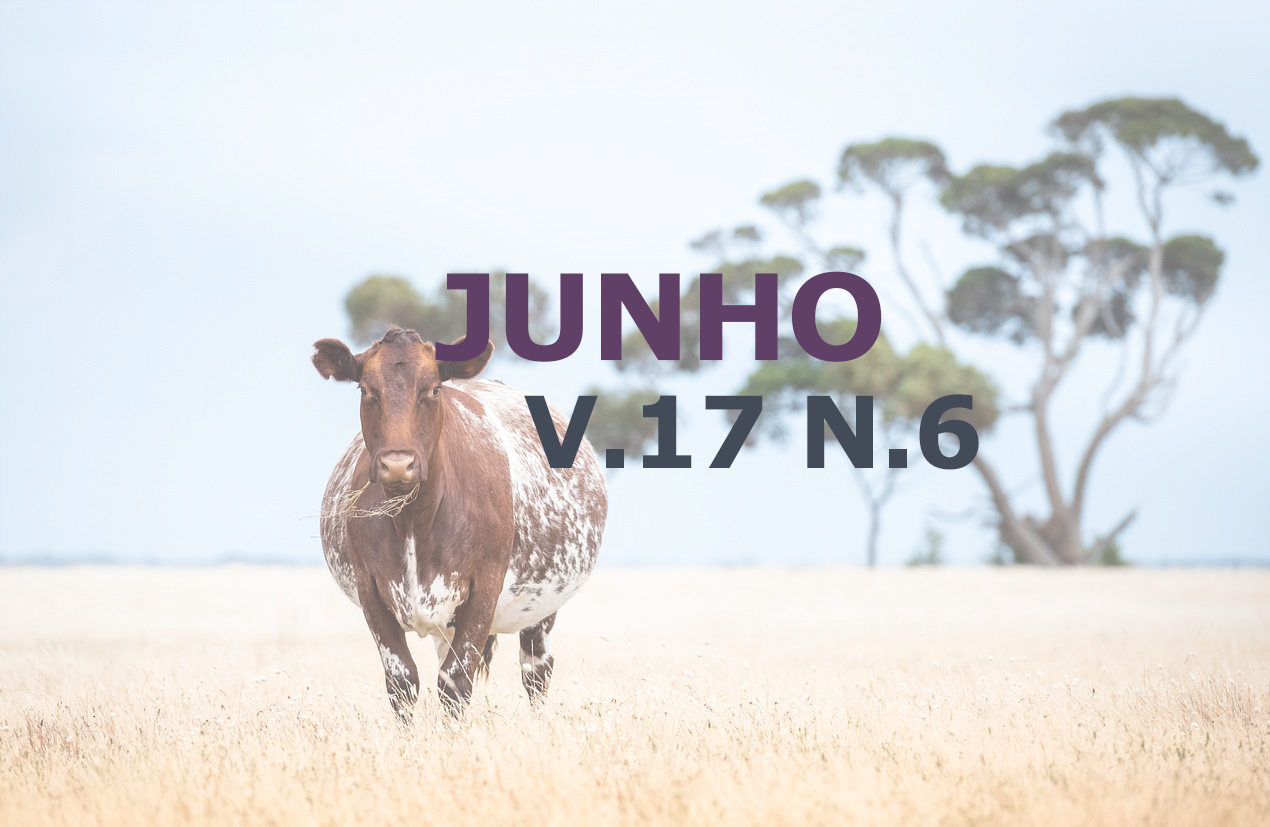Efficiency of different types of inoculants in soybean crop
DOI:
https://doi.org/10.31533/pubvet.v17n6e1400Keywords:
legume, nitrogen, productionAbstract
The inoculation of Bradyrhizobium specific for the soybean crop is an indispensable practice in the cultivation of this leguminous plant. In this study, traditional inoculation via seed was chosen. The experiment was carried out in a soil classified as red oxisol with medium texture in a completely randomized design (DIC), with 4 treatments and 7 repetitions. Each experimental unit was comprised of a 1m² plot, and the treatments analyzed were: Liquid inoculant (T1); Peat inoculant (T2); Liquid + peat inoculant (T3) and no inoculant (T4). The objective proposed in this study was to verify the need to use inoculants in soybean planting in areas where the crop has been cultivated for more than six years. According to the F test, there was a significant difference between the treatments, with T3 standing from among the others for root length, number of nodules and nitrogen concentration on the leaf. T2, although inferior to T3, showed better results than treatments T1 and T4. In the experimental conditions using the Brasmax Bônus8579IPRO cultivar, there was a significant difference in the use of the products, with emphasis on the liquid inoculation + peat (T3), presenting a higher frequency concentration in the plant leaf, obtaining an even greater number of nodules and root length. As the value of the F statistic for the variables average root length, average number of nodes and average leaf transmit nitrogen content exceeds the critical value at the 1% probability level (4.72), they are represented at this level (P < 0 ,01). As the calculated F values were greater than the tabulated F values for the three analyzed variables, we rejected the null hypothesis (H0), and concluded that the determining variables have different effects. Therefore, we can conclude that the most recommended for inoculation would be the use both products.
References
Battisti, A. M., & Simonetti, A. P. M. (2014). Inoculação e Co inoculação com Bradyrhizobium japonicum e Azospirillum brasilense na cultura da soja. Revista Cultivando o Saber, 8(3), 294–301. https://doi.org/10.14393/ufu.te.2019.1247.
Braccini, A. L., Mariucci, G. E. G., Suzukawa, A. K., Lima, L. H. S., & Piccinin, G. G. (2016). Co-inoculação e modos de aplicação de Bradyrhizobium japonicum e Azospirillum brasilense e adubação nitrogenada na nodulação das plantas e rendimento da cultura da soja. Scientia Agraria Paranaensis, 15(1), 27–35. https://doi.org/10.18188/1983-1471/sap.v15n1p27-35.
Bulegon, L. G., Rampim, L., Klein, J., Kestring, D., Guimarães, V. F., Battistus, A. G., & Inagaki, A. M. (2016). Componentes de produção e produtividade da cultura da soja submetida à inoculação de Bradyrhizobium e Azospirillum. Terra Latinoamericana, 34(2), 169–176. https://doi.org/10.22533/at.ed.58222180413.
Chibeba, A. M., Guimarães, M. F., Brito, O. R., Araújo, R. S., Nogueira, M. A., & Hungria, M. (2015). Tecnologia e mercado global: Perspectivas para a soja. Congresso Brasileiro de Soja.
Fachinelli, R., & Ceccon, G. (2020). Coinoculação com Bradyrhizobium e Azospirillum na soja em sucessão ao milhosafrinha em solo arenoso e argiloso. In Embrapa Acre-Circular Técnica (pp. 1–10). Acta Iguazu, Cascavel, v. 9, n. 2, p. 99-108, 2020.
Fipke, G. M. (2015). Co-inoculação e pré-inoculação de sementes em soja. Universidade Federal de Santa Maria.
Hungria, M., Nogueira, M. A., & Araújo, R. S. (2013). Tecnologia de coinoculação da soja com Bradyrhizobium e Azospirillum: incrementos no rendimento com sustentabilidade e baixo custo. XXXIII Reunião de Pesquisa de Soja Da Região Central do Brasil. https://doi.org/10.46311/ed.un.20221018145.
Naoe, A. M. L., Peluzio, J. M., Campos, L. J. M., Naoe, L. K., & Silva, R. A. (2019). Coinoculação com Azospirillum brasilense em cultivares de soja submetidas a deficit hídrico. Revista Brasileira de Engenharia Agrícola e Ambiental, 24(2), 89–94. https://doi.org/10.1590/1807-1929/agriambi.v24n2p89-94.
Pastore, A. (2016). Manejo de inoculação com Bradyrhizobium em soja associado ao tratamento fitossanitário das sementes. Universidade Federal do Parná.
Pias, T. H. (2014). Diferentes tipos de tratamentos de sementes para a cultura da soja (glycine max L.). Universidade Regional do Noroeste do Estado do Rio Grande do Sul.
R-Core-Team. (2016). R: A language and environment for statistical computing. R. Foundation for Satatical Computing.
Sordi, A., Scheneider, F., Panizzon, L. C., Lajús, C. R., Cericato, A., & Klein, C. (2017). Eficiência agronômica da cultura da soja (Glycine max (L.) Merril) submetida a coinoculação. Scientia Agraria, 18(4), 72–79. https://doi.org/10.5380/rsa.v18i4.52047.
Zuffo, A. M., Adriano, T. B., Pedro, M. R., Mariane, C. B., Everton, V. Z., Igor, O. S., Augusto, B. M. R., & Guilherme, L. D. V. (2016). Morphoagronomic and productive traits of RR soybean due to inoculation via Azospirillum brasilense groove. African Journal of Microbiology Research, 10(13), 438–444. https://doi.org/10.5897/ajmr2015.7682
Zuffo, A. M., Rezende, P. M., Bruzi, A. T., Oliveira, N. T., Soares, I. O., Neto, G. F. G., Cardillo, B. E. S., & Silva, L. O. (2015). Co-inoculation of Bradyrhizobium japonicum and Azospirillum brasilense in the soybean crop. Revista de Ciências Agrárias, 38(1), 87–93. https://doi.org/10.5433/1679-0359.2020v41n6Supl2p2937
Downloads
Published
Issue
Section
License
Copyright (c) 2023 Aurélio Ferreira Melo, Thais Miranda Silva Freitas, Roberto Barbuio, Juracy Mendes Moreira, Antônio Florentino de Lima Junior

This work is licensed under a Creative Commons Attribution 4.0 International License.
Você tem o direito de:
Compartilhar — copiar e redistribuir o material em qualquer suporte ou formato
Adaptar — remixar, transformar, e criar a partir do material para qualquer fim, mesmo que comercial.
O licenciante não pode revogar estes direitos desde que você respeite os termos da licença. De acordo com os termos seguintes:
Atribuição
— Você deve dar o crédito apropriado, prover um link para a licença e indicar se mudanças foram feitas. Você deve fazê-lo em qualquer circunstância razoável, mas de nenhuma maneira que sugira que o licenciante apoia você ou o seu uso. Sem restrições adicionais
— Você não pode aplicar termos jurídicos ou medidas de caráter tecnológico que restrinjam legalmente outros de fazerem algo que a licença permita.





